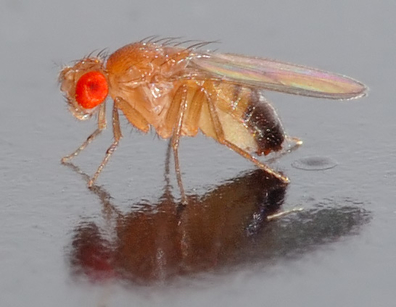 |
 |
 |
 |
 |
 |
 |
 |
|
 |
 |
 |
08 Drosophila melanogaster
|
| Menu | back |
The fruit fly, drosophila melanogaster, has been established as a model organism for genetics since 1908. Over 3,000 mutations of it have been documented to date. Yet, to date, not a single further development towards a new, beneficial blueprint has ever been established.
|
 |
|
For one hundred years, biologists have been using the small fruit fly, drosophila, to carry out thousands of experiments to research the laws of inheritance (1). To this end, biology students have been working in their laboratories with fruit flies, where they attempt to produce new variants by crossing various fruit fly types.
Today, there are thousands of publications on fruit flies. It is the preferred organism for researching evolutionary genetics. It is used because it has a simple genetic structure and is easily bred in the laboratory. Additionally, it contains four pairs of easily studied chromosomes with only 13,000 genes. In March 2000, the complete sequence of the genome of the fruit fly was known (2).
Fruit fly, Drosophila Melanogaster |
Artificially created mutations:
Artificial mutations can be produced in the laboratory using x-rays. That was how, for instance, abnormal wing shapes and colored eyes were created. But despite countless mutations and intelligent human selection, not one new creature ever came into existence. Evolutionist Pierre-P Grassé concluded, The fruit fly, the geneticists favorite research object, the geographic, biotopic, urban and rural variants of which are known back and front, appears to have stayed the same since primeval times" (3).
Adapting to a dry climate
Ary Hoffmann is Director of the Centre for Environmental Stress and Adaptation Research at La Trobe University in Melbourne (Australia). He wanted to know whether the Australian fruit fly drosophila birchii could adapt to a dry climate. In several experiments a group of flies was exposed to a very dry climate, so that ninety percent of them died. He bred the survivors further and exposed them once again to the arid conditions until, again, ninety percent died.
He repeated this for more than thirty generations. The expectation that these flies would adapt to a climate being much drier was not fulfilled (4). Hoffmann and his staff quite quickly identified the limit of adaptation of these flies. If the tropical climate in which these fruit flies lived were actually to become drier, it can be assumed that they would become extinct.
These 09 | Menu |
| back |
(1) Frank Sherwin, Fruit Flies in the Face of Macro evolution, Acts and Facts 35/1, January 2006, page. 5.
(2) Mark D. Adams et al., The Genome Sequence of Drosophila melanogaster, Science 287, 24. March 2000, pages
21852195.
(3) Pierre-P. Grassé, Evolution of living Organisms, New York: Acad. Press, 1977, page. 130.
(4) Terry Lane und Ary Hoffmann in Radio National, The International Interest, http://www.abc.net.au/rn/talks/natint/stories/s911112.htm.
|
Comment this Site!
|
 |
 |
 |
 |
|

